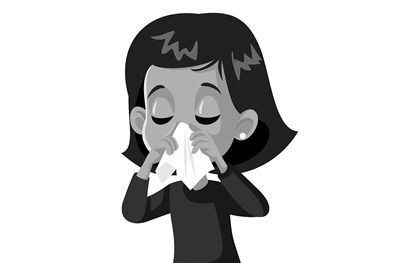
Nasal itching, nasal congestion and runny nose have almost become the “standards” in allergy season, and nasal sprays for various treatments and symptom relief are even more essential. However, these various nasal sprays are not available to buy and use at will. Long-term irregular use of some drugs not only fails to fundamentally control rhinitis, but may even induce drug-induced rhinitis. Today, the doctor will talk to you about the precautions in the use of nasal sprays.
Take you to know the big family of rhinitis medication
Rhinitis is a common disease in otolaryngology. It is mainly characterized by nasal congestion and runny nose. Sexual non-allergic rhinitis and infectious rhinitis. Allergic rhinitis is a non-infectious chronic inflammatory disease of the nasal mucosa mainly mediated by IgE after the body is exposed to allergens. It is divided into seasonal allergic rhinitis and perennial allergic rhinitis. The most common clinical manifestations of various types of rhinitis are nasal congestion and runny nose. Some patients may have nasal itching and paroxysmal sneezing.
Nasal topical medication is the main method for the treatment of acute and chronic rhinitis.
Nasal corticosteroids are the first-line drugs for the treatment of allergic rhinitis, such as budesonide nasal spray and fluticasone propionate nasal spray, which can effectively control nasal congestion, runny nose, and sneezing. and other nasal symptoms.
When it comes to hormones, everyone is definitely more concerned about side effects. In fact, there are few adverse reactions of nasal glucocorticoids, generally mild or severe local reactions such as local irritation, epistaxis, nasal dryness or burning sensation. The use of nasal glucocorticoids does not increase the incidence of common bacterial infections or fungal infections, and has no significant effect on adrenal cortex function, bone metabolism and growth at therapeutic doses.
However, overdose application can cause various adverse reactions, so please follow the doctor’s advice or instructions during medication, and do not increase the dose arbitrarily, especially for children.
Nasal antihistamines This is also the first-line drug for the treatment of allergic rhinitis, and the common azelastine hydrochloride nasal spray belongs to this category. Histamine can stimulate nerve endings to cause itching, stimulate telangiectasia and glandular secretion, and is the main inflammatory mediator that causes nasal symptoms. These drugs can block these reactions caused by histamine and quickly relieve nasal symptoms such as nasal itching and sneezing.
This type of drug has few adverse reactions, the more common ones are bitterness in the mouth and irritation of the throat, which are generally tolerated and do not affect the continued use of the drug. The overall anti-inflammatory activity of nasal antihistamines is slightly weaker than that of nasal glucocorticoids, but the onset is fast, and the two have certain complementary effects.
Nasal decongestants Severe persistent nasal congestion is the main clinical symptom that plagues patients with rhinitis. Nasal decongestants can be used to quickly relieve symptoms of nasal congestion. Oxymetazoline hydrochloride spray belongs to this category.
It should be noted that these drugs are purely symptomatic drugs and can be rapidly effective, but they have no anti-inflammatory effect, and have short-term effects, rapid failure and rebound effects, etc., long-term irregular use Not only can not fundamentally control rhinitis, but may induce drug-induced rhinitis. Therefore, such drugs cannot be used casually as elixir.
The nasal saline wash can remove the thick secretions and external irritants in the nasal cavity, reduce the content of local inflammatory factors, reduce the edema of the nasal mucosa, improve the ventilation and drainage of the nasal cavity and the function of the nasal mucociliary. It is a safe, Effective adjunct for adults and pediatric patients, but with caution in infants and young children.
Correct posture for nasal spray use
Let’s take budesonide nasal spray as an example. Before the first dose, shake the bottle and spray the drug into the air for a few times. (5-10) for an even spray. If you don’t use it for a whole day, you need to repeat the above operation before using it again. This time you only need to spray the air once.
1. Blow your nose, shake the vial, and open the brown protective cap.
2. Hold the bottom of the bottle with your thumb, press your middle finger and index finger on the mouth of the bottle, and hold the bottle.
3. Insert the nozzle into the nostril and spray the prescribed dose. Spray in the other nostril in the same way.
4. Close the bottle cap and do not spray more than the doctor prescribed.
Use Nasal Spray Pay Attention to These Details
In the process of using nasal spray, some small details can determine the effect of medication. Come and check if you did it right.
Tilt your head forward instead of backward to avoid the drug reaching your throat and causing side effects. If the drug flows backward to the pharynx, it should be spit out but not swallowed, otherwise it will easily cause systemic side effects.
Do not insert the nozzle completely into the nose, just insert the nozzle tip into the nose.
When spraying, make sure that the nozzle is pointing in the direction of the outer turbinate of the nasal cavity, not the nasal septum, to avoid damage to the nasal cavity.
In order to ensure the contact time between the drug and the mucous membrane and the absorption of the drug, avoid inhaling and blowing the nose immediately after the drug is finished.
Avoid using the same nasal spray with multiple people to avoid cross-infection. When multiple drugs are administered at the same time, the interval should be no less than 3 minutes, so as to avoid the reduction of the efficacy or the occurrence of adverse reactions.
Be aware of medication storage methods. Due to the different requirements of different manufacturers, store it strictly according to the instructions. The nasal spray should not be frozen and should be used within 6 months after opening the bottle.
Text/Song Qin (Beijing Xiaotangshan Rehabilitation Hospital)